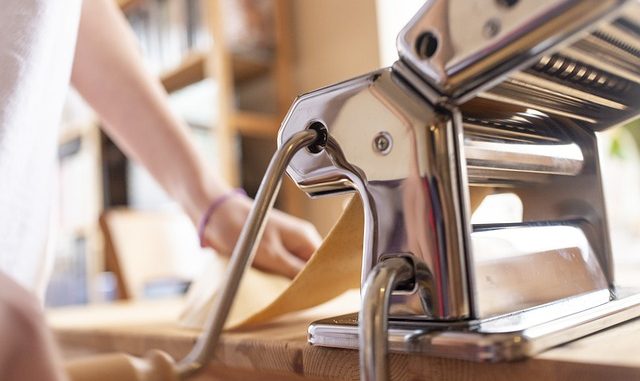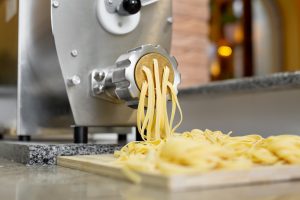
Making fresh pasta for all sorts of dishes is a skill worth mastering by any chef. Especially when it comes to the filled types such as ravioli and tortellini. With practice it becomes a very easy task.
The manual method below takes about 15 minutes to make the dough and 30 minutes for it to rest in the fridge. All fresh pasta will only take between 2 and 3 minutes to cook in salted boiling water. Good quality dried pasta takes about 13 to 15 minutes on average. A little bit of time is needed for resting.
Most versions will use a strong white flour. The most authentic is an Italian Durum wheat which is often sold as Tipo ’00’ flour. If that is not to hand then all-purpose flour needs to be used but the texture, may well be softer than desired.
Egg pasta is a great favourite because egg yolks generate the right level of texture on cooking.
Pasta is highly versatile. If you like recipes that use tagliatelle or fettucine then try sauces such as tomato. We have also discussed briefly the industrial manufacture and the principles of manufacture are not that much different from the methods used in the home. There is also similarities of sorts with noodle making which is what pasta truly is but here the ingredients are different but the methods of preparation are similar. Gluten-free pasta is made to a great extent with rice flour but yellow pea, chickpea, soya-edamame are also becoming acceptable.
Serves 8 people.
[Please note we are an affiliate marketing partner and will make a sales commission if you purchase any items through our affiliate links. Please read our affiliate disclosure]
Equipment:
Ingredients:
- 300g ‘00’ pasta flour, with extra for dusting
- 2 eggs and 2 to 4 yolks, lightly beaten
- semolina flour or plain white flour, for dusting
Dough Preparation:
The Manual Preparation Method:
- On a clean flat board or kitchen surface, make a mound of the flour. With the tips of the fingers make a well so that it looks like the cone of a volcano.
- Crack the eggs and add the yolks to a medium sized bowl and beat with a fork until smooth.
- Pour the egg into the well of the flour and gently mix this with the flour. You could do all this in a bowl too but the way I learnt it was to do the ‘well’ thing.
- Start mixing it all thoroughly with the tips of the fingers until flour and egg are fully combined.
- Knead the dough together and this requires work as if you are preparing bread dough by hand. You may need more flour to stop the dough sticking to the surface and you may need to add a small amount of water just to stop it all being too dry. This part comes with experience. The aim is to create a large, smooth lump of dough.
- The kneading causes the gluten in the dough to stretch and combine with the starch. Working with the hands stops the dough becoming soft and plastic. It should start to have an elastic feel to it. Many home chefs just bash it, hit it and do all sorts of things with it because it’s about using energy to modify the dough structure.
- It is ready when the dough no longer looks floury and really rough but smooth and silky. Just keep working it if there are still lumps – nobody likes lumps!
- Wrap the dough thoroughly in clingfilm and place in the fridge for resting. About 30 minutes is enough.
Food Processor Method:
Add the flour and about 2/3rds of the egg to the bowl. Use a slicer or a dough hook and literally blitz the mixture until it forms lumps. Add the remaining egg and continue to mix on as slow a setting as possible. It doesn’t really matter if you haven’t that level of control but the intention is to have generated lumps which can be removed for kneading together in the next stages.
Rolling: Rolling Pin
To make flat pasta means putting the dough onto a clean flat surface which has some dusting flour like semolina or the flour you just used.
Most Italians would use a rolling pin and simply roll it out. The key is to get it as flat and as thin as possible.
Rolling: Pasta Machine
- If you are using a pasta maker or a pasta machine then make sure it is securely fixed to the kitchen work surface. Choose one that isn’t going to mark it.
- Take portions of dough as no-one wants to be seen trying to get a massive piece through one of these machines. It doesn’t work! Best to roll small pieces of dough. The size of an apple or orange is best.
- Begin with the widest setting on the pasta machine and just roll the dough through it. keep dusting the pasta with flour if it sticks. Fold it into a flat sandwich ready for rerolling. Don’t create another ball but have it suitable for another roll.
- Take the settings down by a notch each time and reroll the pasta. I have to do this 5 maybe 6 times. The dough should be a flat piece each time. If it gets folded a few times that’s no big deal as the dough is being worked continuously and the gluten is being worked to create that smooth silky structure ideal for al dente after cooking. Keep dusting the sides lightly after each pass.
- If the dough starts to crack then just refold it and work it through the machine again. Eventually it should be a thin silky sheet with the depth of a credit card.

Cutting And Shaping Fresh Pasta
Once you are happy with it as a flat sheet then is the time to cut and shape the dough. Don’t leave it to dry out as the shaping needs to be done immediately.
For fettucine, lasagne and tagliatelle, just leave it and cut using settings that hopefully are available on your pasta machine.
If making tortellini or ravioli then roll it down to the point where you could see your hand through the dough. It will be flimsy and tricksy to handle but it needs to be this thin for any filled pasta.
Pasta dries out really quickly at this point so most chefs place a slightly damp but clean tea towel over it prior to the next steps.
If you cannot use it there and then then dust in semolina flour or ’00’ flour and set aside. Store in a sealed container in the fridge and use within a couple of days, or freeze for 1 month.

Leave a Reply